MAXIMIZE YOUR BUSINESS TAXES: 10 PROVEN TAX PLANNING STRATEGIES FOR SMALL BUSINESS OWNERS
As a small business owner in Canada, managing your finances effectively is crucial to your success. One of the most critical aspects of financial management is tax planning. With the right tax planning strategies, you can minimize your tax liability, maximize your cash flow, and achieve your business goals.
In this article, we will explore the importance of tax planning for small business owners, discuss common tax planning strategies, and provide practical tips on how to optimize your business taxes. Whether you are a seasoned entrepreneur or just starting out, this article will provide you with the knowledge and expertise you need to take control of your business taxes.
WHY IS TAX PLANNING IMPORTANT FOR SMALL BUSINESS OWNERS?

Tax planning is essential for small business owners because it can help you:
- Minimize Tax Liability
Tax planning helps small business owners minimize their tax liability, ensuring they don’t overpay taxes. By taking advantage of available tax deductions and credits, business owners can reduce their taxable income.
- Maximize Cash Flow
Effective tax planning enables small business owners to manage their cash flow better. By reducing tax liabilities, business owners can retain more of their hard-earned profits, which can be reinvested in the business or used for personal expenses.
- Achieve Business Goals
Tax planning is essential for achieving business goals, such as expanding operations, increasing profitability, or exiting the business. By optimizing their tax strategy, small business owners can make informed decisions about their business’s future.
- Reduce Stress and Complexity
Tax planning can help reduce the stress and complexity associated with managing taxes. By seeking professional advice and staying organized, small business owners can navigate the tax system with confidence.
- Stay Compliant
Tax planning ensures that small business owners comply with Canada’s tax laws and regulations. By meeting their tax obligations, business owners can avoid penalties, fines, and reputational damage.
- Take Advantage of Tax Incentives
Canada offers various tax incentives for small businesses, such as the Scientific Research and Experimental Development (SR&ED) tax credit. Tax planning helps business owners identify and claim these incentives, which can provide significant tax savings.
- Plan for Succession
Tax planning is essential for small business owners who plan to pass their business to the next generation or sell their business. By developing a tax-efficient succession plan, business owners can minimize taxes and ensure a smooth transition.
- Protect Against Tax Audits
Tax planning helps small business owners prepare for tax audits by maintaining accurate records and ensuring compliance with tax laws. This can reduce the risk of tax penalties and reputational damage.
- Improve Financial Management
Tax planning is an integral part of financial management for small businesses. By developing a tax strategy, business owners can better manage their finances, make informed decisions, and drive business growth.
- Enhance Business Value
Effective tax planning can enhance the value of a small business. By minimizing tax liabilities and maximizing cash flow, business owners can increase the value of their business, making it more attractive to potential buyers or investors.
TYPES OF BUSINESS TAXES
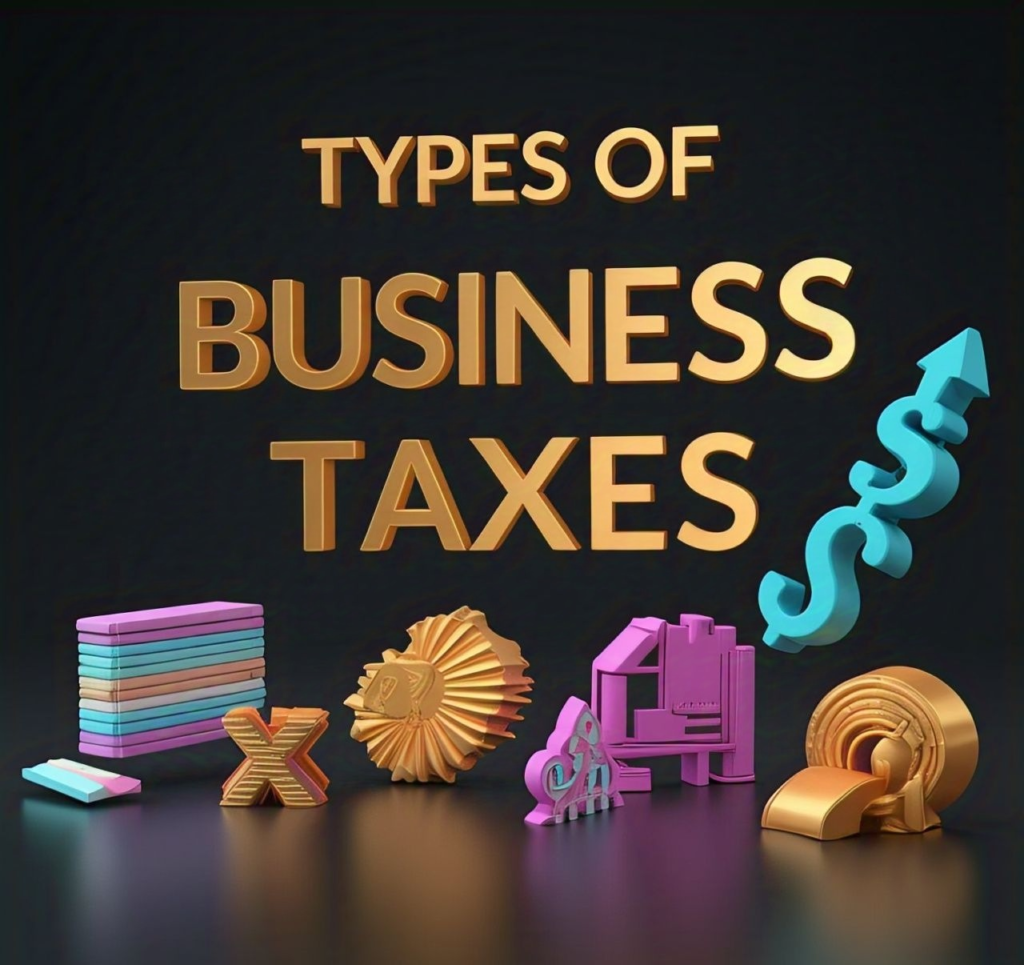
1. Corporate Income Tax
– Tax on a corporation’s taxable income
– Federal and provincial corporate tax rates apply
2. Small Business Tax
– Reduced corporate tax rate for small businesses
– Qualifying businesses must meet specific criteria, such as having a limited amount of taxable capital employed in Canada
3. Goods and Services Tax (GST)
– Federal tax on the supply of goods and services
– Businesses must register for a GST account if they earn more than $30,000 in revenue
4. Harmonized Sales Tax (HST)
– Combined federal and provincial tax on the supply of goods and services
– Applies in participating provinces
5. Provincial Sales Tax (PST)
– Tax on the sale of goods and services, levied by provinces
– Rates vary by province
6. Payroll Taxes
– Canada Pension Plan (CPP) contributions
– Employment Insurance (EI) premiums
– Provincial payroll taxes
7. Property Taxes
– Real property taxes (land and buildings)
– Personal property taxes (equipment and inventory)
8. Carbon Tax
– Federal tax on fossil fuels
– Applies in provinces without a provincial carbon pricing system
9. Import/Export Taxes
– Taxes on imported goods
– Duties and taxes on exported goods
10. Provincial Taxes
– Provincial corporate income tax
– Provincial sales tax
– Provincial payroll taxes
11. Withholding Tax
– Tax withheld on income earned by non-resident individuals and corporations
12. Transfer Pricing
– Rules governing the pricing of transactions between related parties
13. Employer Health Tax
– Tax levied by provinces on employers to fund health care
14. Workers’ Compensation Premiums
– Premiums paid by employers to fund workers’ compensation benefits
By understanding these types of business taxes in Canada, small business owners can better navigate the tax system and optimize their tax planning strategies.
TAX FILING REQUIREMENTS FOR SMALL BUSINESSES IN CANADA
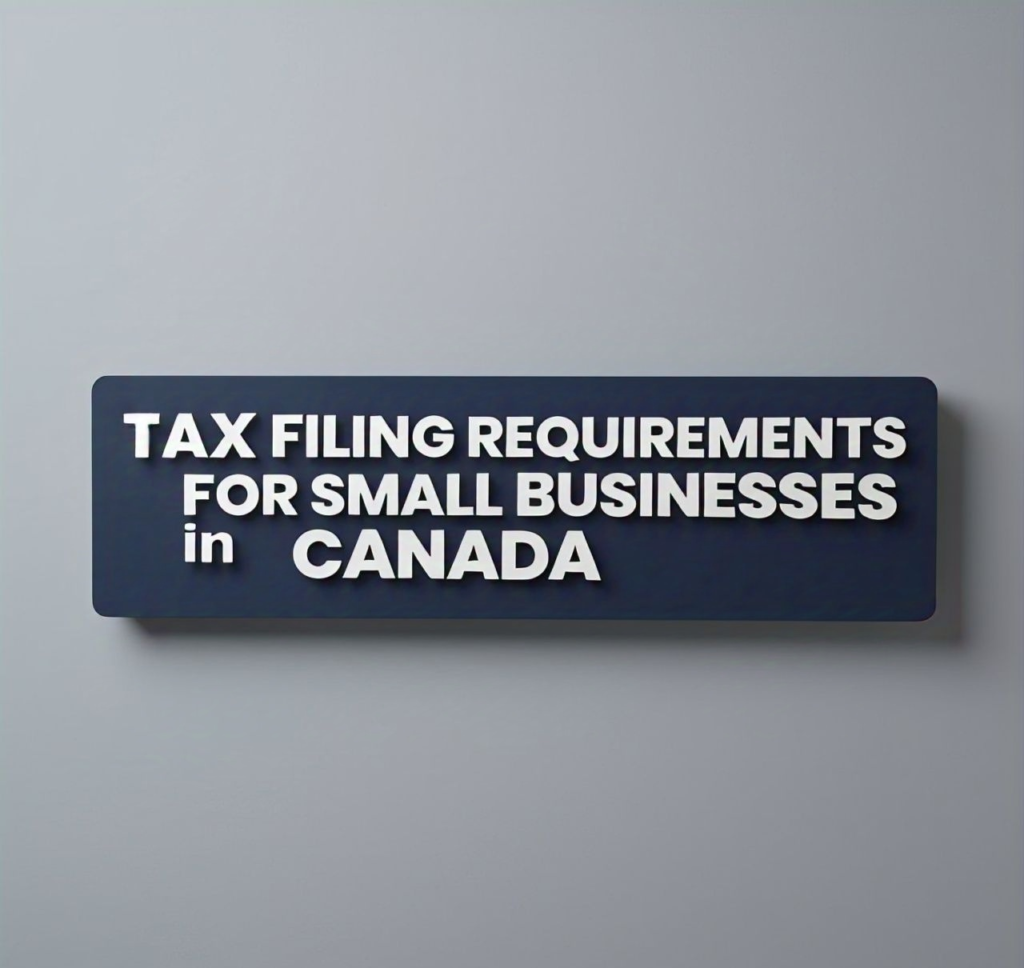
To ensure compliance with Canadian tax laws, small businesses must fulfill specific tax filing requirements. Here’s a breakdown of these obligations:
Business Structure and Filing Requirements
– Sole Proprietorships: File a personal income tax return (T1) and report business income on Form T2125, Statement of Business or Professional Activities.
– Partnerships: File a partnership information return (T5013) and provide each partner with a T5013 Statement of Partnership Income.
– Corporations: File a corporation income tax return (T2) every tax year, even if there’s no tax payable.
Tax Filing Deadlines
– T1 (Personal Income Tax Return): June 15th for self-employed individuals and their spouses.
– T2 (Corporation Income Tax Return): Six months after the end of the corporation’s tax year.
– T5013 (Partnership Information Return): March 31st for partnerships that have a December 31st year-end.
Other Filing Requirements
– GST/HST Returns: File quarterly or annually, depending on the business’s GST/HST reporting period.
– Payroll Deductions: File payroll deductions remittances and reports (e.g., T4, T4A) by the required deadlines.
Penalties for Non-Compliance
Failure to file tax returns or remit taxes on time can result in penalties and interest charges. To avoid these consequences, ensure your small business meets its tax filing requirements.
For more information on tax filing requirements for small businesses in Canada, visit the Canada Revenue Agency (CRA) website or consult with a tax professional.
COMMON TAX MISTAKES MADE BY SMALL BUSINESS OWNERS IN CANADA

1. Inaccurate or Incomplete Records
– Failure to maintain accurate and detailed financial records
– Incomplete or missing receipts, invoices, and bank statements
2. Missed Deadlines
– Failing to file tax returns on time
– Missing deadlines for GST/HST, payroll, and other tax remittances
3. Incorrect Business Structure
– Choosing the wrong business structure (e.g., sole proprietorship, partnership, corporation)
– Not considering tax implications when selecting a business structure
4. Insufficient Tax Planning
– Not seeking professional tax advice
– Failing to plan for taxes throughout the year
5. Overlooking Tax Credits and Deductions
– Missing eligible tax credits (e.g., SR&ED, hiring credits)
– Overlooking tax deductions (e.g., business use-of-home expenses, CCA)
6. Incorrect GST/HST Reporting
– Failing to charge GST/HST on taxable supplies
– Incorrectly claiming GST/HST credits
7. Non-Compliance with Payroll Regulations
– Failing to remit payroll deductions on time
– Incorrectly calculating payroll taxes
8. Not Keeping Personal and Business Finances Separate
– Commingling personal and business funds
– Using business funds for personal expenses
9. Failing to File T4s and T4As
– Not filing T4s and T4As for employees and contractors
– Failing to provide accurate and timely T4 and T4A slips
10. Not Staying Up-to-Date on Tax Changes
– Failing to stay informed about tax law changes and updates
– Not adapting tax planning strategies to reflect changes in tax laws and regulations
By being aware of these common tax mistakes, small business owners in Canada can take steps to avoid them and ensure they’re in compliance with tax laws and regulations.
COMMON TAX PLANNING STRATEGIES FOR SMALL BUSINESS OWNERS
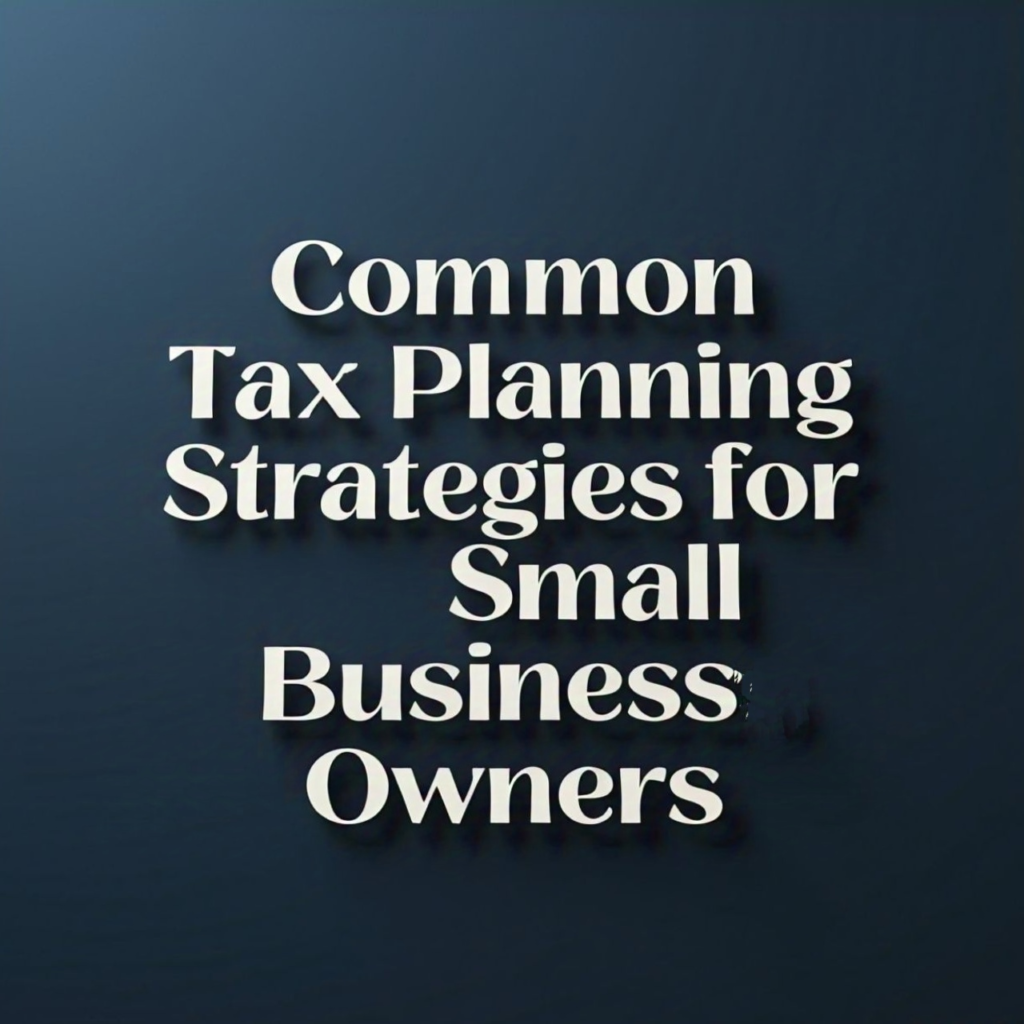
Here are some common tax planning strategies that small business owners can use to optimize their business taxes:
1. Income Splitting
Income splitting involves dividing business income among family members or other individuals to reduce tax liability. This can be achieved through various means, such as:
– Paying salaries or wages to family members
– Issuing dividends to shareholders
– Transferring ownership of business assets to family members
2. Capital Cost Allowance (CCA)
CCA is a tax deduction that allows businesses to claim the depreciation of assets over time. This can include:
– Buildings and structures
– Machinery and equipment
– Vehicles
– Technology and software
3. Home Office Deduction
If you work from home, you may be eligible for the home office deduction. This allows you to claim a portion of your rent or mortgage interest as a business expense.
4. Business Use-of-Home Expenses
If you use a dedicated space in your home for business purposes, you may be eligible to claim business use-of-home expenses. This can include:
– Utilities
– Insurance
– Maintenance costs
5. Charitable Donations
Charitable donations can provide a tax deduction, reducing your taxable income. Consider donating to registered charities or other qualified organizations.
6. Scientific Research and Experimental Development (SR&ED) Tax Credit
If your business engages in scientific research or experimental development, you may be eligible for the SR&ED tax credit. This can provide a significant tax refund.
7. Hiring Family Members
Hiring family members can provide tax benefits, such as:
– Paying salaries or wages to family members
– Issuing dividends to shareholder family members
– Transferring ownership of business assets to family members
8. Corporate Tax Planning
Corporate tax planning involves optimizing your business’s tax structure to minimize tax liability. This can include:
– Choosing the right business structure (e.g., sole proprietorship, partnership, corporation)
– Optimizing share ownership and dividend payments
– Managing corporate tax rates and surtaxes
9. Retirement Planning
Retirement planning is essential for small business owners. Consider:
– Registered Retirement Savings Plans (RRSPs)
– Registered Education Savings Plans (RESPs)
– Individual Pension Plans (IPPs)
– Retirement compensation arrangements (RCAs)
10. Estate Planning
Estate planning involves planning for the transfer of your business assets after death. Consider:
– Wills and trusts
– Estate freezes
– Shareholder agreements
– Business succession planning
11. Tax Loss Planning
Tax loss planning involves using business losses to reduce tax liability. Consider:
– Carrying back losses to previous years
– Carrying forward losses to future years
– Using losses to reduce taxable income
12. Asset Protection
Asset protection involves protecting your business assets from creditors and other risks. Consider:
– Incorporating your business
– Using trusts and holding companies
– Implementing a shareholder agreement
13. Cross-Border Tax Planning
Cross-border tax planning involves optimizing your business’s tax structure for international operations. Consider:
– Choosing the right business structure for international operations
– Managing withholding taxes and tax treaties
– Optimizing transfer pricing and intercompany transactions
14. Provincial Tax Planning
Provincial tax planning involves optimizing your business’s tax structure for provincial taxes. Consider:
– Choosing the right business structure for provincial taxes
– Managing provincial tax rates and surtaxes
– Optimizing provincial tax credits and incentives
15. GST/HST Planning
GST/HST planning involves optimizing your business’s tax structure for goods and services tax (GST) and harmonized sales tax (HST). Consider:
– Registering for a GST/HST account
– Managing GST/HST rates and exemptions
– Optimizing GST/HST credits and rebates
These tax planning strategies can help small business owners in Canada minimize their tax liability, maximize their cash flow, and achieve their business goals. However, it’s essential to consult with a tax professional to determine the best tax planning strategies for your specific business needs.
TAX DEDUCTIONS AND CREDITS FOR SMALL BUSINESS OWNERS IN CANADA
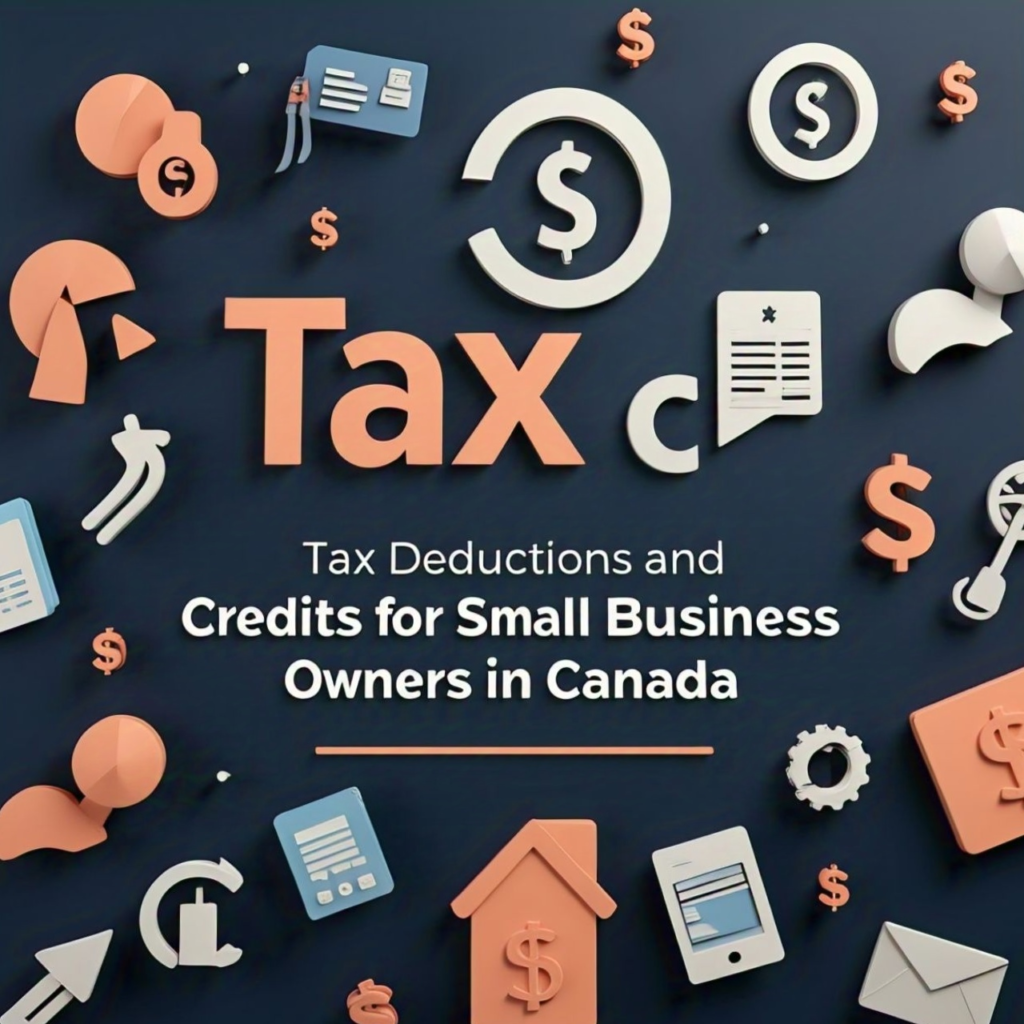
Tax Deductions
1. Business Use-of-Home Expenses: Deduct a portion of rent or mortgage interest, utilities, and maintenance costs for a home office.
2. Capital Cost Allowance (CCA): Depreciate assets like equipment, vehicles, and buildings.
3. Travel Expenses: Deduct reasonable travel expenses, including transportation, meals, and accommodations.
4. Meals and Entertainment: Deduct 50% of eligible meals and entertainment expenses.
5. Business Insurance: Deduct premiums for business insurance, including liability and property insurance.
6. Professional Fees: Deduct fees for professional services, including accounting, legal, and consulting services.
7. Salaries and Wages: Deduct salaries and wages paid to employees.
8. Rent and Utilities: Deduct rent and utility costs for business premises.
Tax Credits
1. Scientific Research and Experimental Development (SR&ED) Tax Credit: Claim a tax credit for research and development expenses.
2. Hiring Credit: Claim a tax credit for hiring new employees.
3. Apprenticeship Job Creation Tax Credit: Claim a tax credit for hiring apprentices.
4. Investment Tax Credit: Claim a tax credit for investing in small businesses or start-ups.
5. Film and Video Production Tax Credit: Claim a tax credit for film and video production expenses.
6. Digital Media Tax Credit: Claim a tax credit for digital media development expenses.
7. Environmental Tax Credits: Claim tax credits for environmental initiatives, such as energy-efficient equipment and green technologies.
Other Incentives
1. Small Business Deduction: Reduce corporate income tax rates for small businesses.
2. Home Buyers’ Plan: Withdraw up to $35,000 from an RRSP to purchase a home.
3. Lifetime Capital Gains Exemption: Exempt up to $883,383 of capital gains from taxation.
Provincial and Territorial Incentives
1. Provincial Tax Credits: Claim tax credits for specific industries or initiatives, such as film production or environmental technologies.
2. Provincial Grants: Apply for grants for specific business initiatives, such as research and development or exporting.
By taking advantage of these tax deductions, credits, and incentives, small business owners in Canada can reduce their tax liability and increase their cash flow. Consult with a tax professional to determine which incentives are available to your business.
TAX PLANNING FOR DIFFERENT BUSINESS STRUCTURES IN CANADA
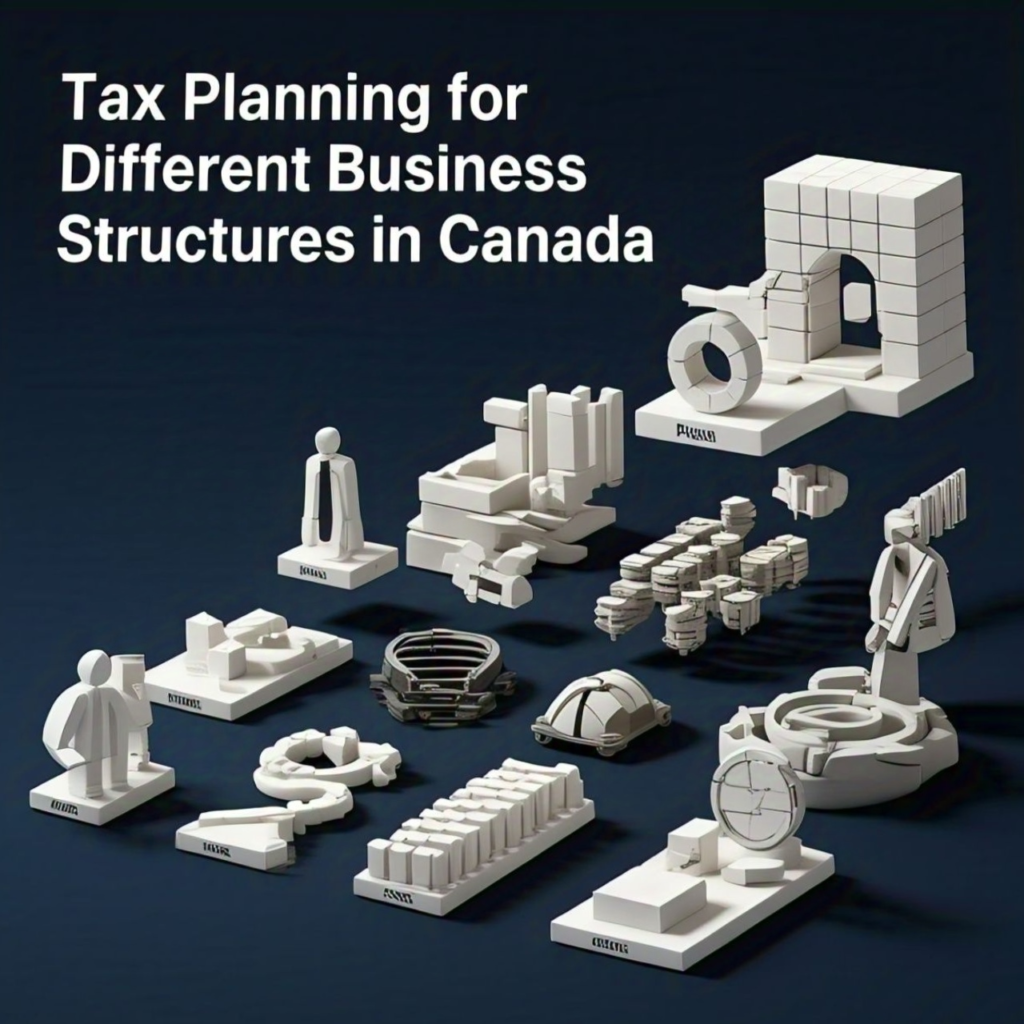
Here’s a breakdown of tax planning strategies for different business structures in Canada:
Sole Proprietorship
1. Business Income: Report business income on personal tax return (T1).
2. Business Expenses: Claim business expenses on Form T2125.
3. Home Office Deduction: Claim home office deduction if working from home.
4. Capital Cost Allowance (CCA): Claim CCA on business assets.
Partnership
1. Partnership Return: File partnership return (T5013) to report partnership income.
2. Partner’s Share: Each partner reports their share of partnership income on their personal tax return (T1).
3. Business Expenses: Claim business expenses on Form T2125.
4. CCA: Claim CCA on business assets.
Corporation
1. Corporate Tax Return: File corporate tax return (T2) to report corporate income.
2. Corporate Tax Rate: Pay corporate tax rate on taxable income.
3. Dividend Taxation: Pay dividend tax on dividends distributed to shareholders.
4. CCA: Claim CCA on business assets.
Hybrid Structures
1. Holding Company: Use a holding company to hold shares of operating company.
2. Trust: Use a trust to distribute income to beneficiaries.
3. Partnership with a Corporation: Use a partnership with a corporation to reduce tax liability.
Tax Planning Strategies
1. Income Splitting: Split income among family members or shareholders to reduce tax liability.
2. Capital Gains Exemption: Claim capital gains exemption on sale of qualified small business corporation shares.
3. Dividend Sprinkling: Sprinkle dividends among family members or shareholders to reduce tax liability.
4. Corporate Reorganization: Reorganize corporate structure to reduce tax liability.
Provincial Tax Considerations
1. Provincial Tax Rates: Consider provincial tax rates when choosing a business structure.
2. Provincial Tax Credits: Claim provincial tax credits for specific industries or initiatives.
3. Provincial Sales Tax: Consider provincial sales tax implications when choosing a business structure.
By understanding the tax implications of different business structures and implementing effective tax planning strategies, small business owners in Canada can minimize their tax liability and maximize their cash flow. Consult with a tax professional to determine the best business structure and tax planning strategies for your business.
PRACTICAL TIPS FOR OPTIMIZING YOUR BUSINESS TAXES
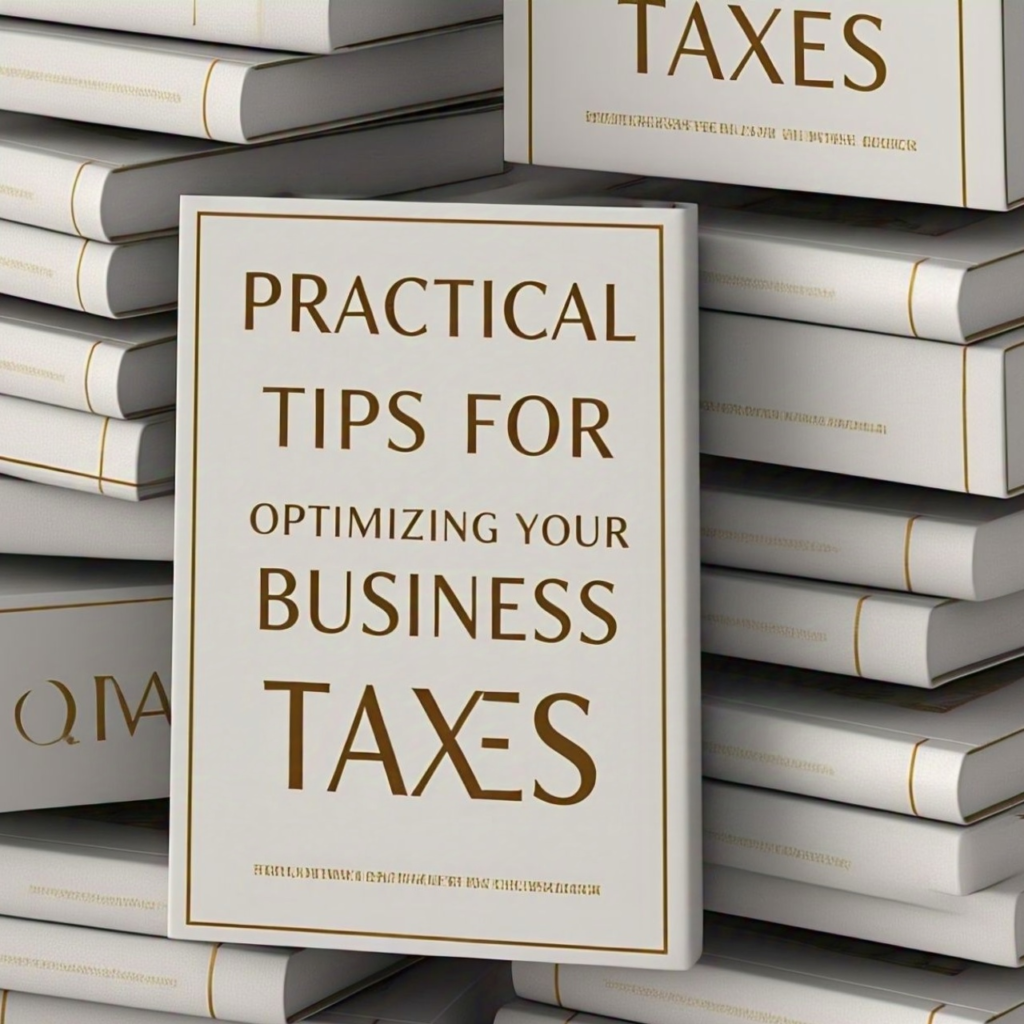
Here are some practical tips for optimizing your business taxes:
Record Keeping
1. Maintain accurate records: Keep track of all business income and expenses, including receipts, invoices, and bank statements.
2. Use accounting software: Utilize cloud-based accounting software like QuickBooks, Xero, or Wave to streamline record-keeping and reduce errors.
Tax Deductions
1. Claim business expenses: Deduct business-related expenses, such as travel, meals, and equipment costs.
2. Take advantage of home office deductions: Claim a portion of your rent or mortgage interest as a business expense if you work from home.
3. Claim capital cost allowance (CCA): Depreciate business assets, such as equipment, vehicles, and buildings.
Tax Credits
1. Scientific Research and Experimental Development (SR&ED) tax credit: Claim a tax credit for research and development expenses.
2. Hiring credits: Claim tax credits for hiring employees, such as the Canada Job Grant.
3. Investment tax credits: Claim tax credits for investing in small businesses or start-ups.
Corporate Tax Planning
1. Choose the right business structure: Select a business structure that minimizes tax liability, such as a corporation or partnership.
2. Optimize share ownership: Structure share ownership to minimize tax liability and maximize tax benefits.
3. Manage corporate tax rates: Take advantage of lower corporate tax rates for small businesses.
Personal Tax Planning
1. Split income with family members: Split business income with family members to reduce tax liability.
2. Take advantage of personal tax credits: Claim personal tax credits, such as the basic personal amount, medical expense tax credit, and charitable donation tax credit.
3. Contribute to a Registered Retirement Savings Plan (RRSP): Reduce taxable income by contributing to an RRSP.
GST/HST Planning
1. Register for a GST/HST account: Register for a GST/HST account if your business earns more than $30,000 in revenue.
2. Claim GST/HST credits: Claim GST/HST credits for business expenses.
3. Manage GST/HST rates: Take advantage of lower GST/HST rates for certain goods and services.
Provincial Tax Planning
1. Understand provincial tax rates: Understand provincial tax rates and how they apply to your business.
2. Claim provincial tax credits: Claim provincial tax credits, such as the Ontario Innovation Tax Credit.
3. Manage provincial tax exemptions: Take advantage of provincial tax exemptions for certain goods and services.
Year-End Tax Planning
1. Review financial statements: Review financial statements to identify tax planning opportunities.
2. Accelerate expenses: Accelerate business expenses to reduce taxable income.
3. Defer income: Defer business income to reduce taxable income.
Seeking Professional Advice
1. Consult a tax professional: Consult a tax professional to ensure you are taking advantage of all available tax planning opportunities.
2. Stay up-to-date on tax changes: Stay informed about tax changes and how they apply to your business.
3. Review and adjust tax planning strategies: Regularly review and adjust tax planning strategies to ensure they remain effective.
RECORD KEEPING AND ACCOUNTING FOR SMALL BUSINESSES IN CANADA

Record Keeping Requirements
1. Business Records: Maintain accurate and detailed records of business transactions, including income, expenses, assets, liabilities, and equity.
2. Supporting Documents: Keep supporting documents, such as receipts, invoices, bank statements, and cancelled checks.
3. Employee Records: Maintain employee records, including payroll information, benefits, and tax deductions.
4. GST/HST Records: Keep records of GST/HST charged and collected, as well as GST/HST paid on business expenses.
Accounting Methods
1. Cash Method: Record income and expenses when cash is received or paid.
2. Accrual Method: Record income and expenses when earned or incurred, regardless of when cash is received or paid.
3. Hybrid Method: Combine cash and accrual methods for different types of transactions.
Accounting Systems
1. Manual Accounting: Use a manual accounting system, such as a ledger or spreadsheet.
2. Cloud Accounting: Use cloud-based accounting software, such as QuickBooks, Xero, or Wave.
3. Accounting Software: Use desktop accounting software, such as Sage or Simply Accounting.
Financial Statements
1. Balance Sheet: Prepare a balance sheet to show assets, liabilities, and equity.
2. Income Statement: Prepare an income statement to show revenues, expenses, and net income.
3. Cash Flow Statement: Prepare a cash flow statement to show inflows and outflows of cash.
Tax Compliance
1. GST/HST Returns: File GST/HST returns and remit GST/HST owed.
2. Corporate Tax Returns: File corporate tax returns (T2) and pay corporate taxes owed.
3. Payroll Remittances: File payroll remittances and pay payroll taxes owed.
Best Practices
1. Regularly Review Financial Statements: Regularly review financial statements to ensure accuracy and identify areas for improvement.
2. Maintain Accurate Records: Maintain accurate and detailed records to support financial statements and tax returns.
3. Seek Professional Advice: Seek professional advice from an accountant or bookkeeper to ensure compliance with accounting and tax regulations.
By following these guidelines, small businesses in Canada can ensure accurate and compliant record keeping and accounting practices, which are essential for optimizing business taxes and achieving long-term success.
TAX PLANNING STRATEGIES FOR SELF-EMPLOYED INDIVIDUALS IN CANADA

Business Structure
1. Sole Proprietorship: Report business income on personal tax return (T1).
2. Partnership: File partnership return (T5013) and report partnership income on personal tax return (T1).
3. Incorporation: Consider incorporating to reduce tax liability and increase business credibility.
Business Expenses
1. Home Office Expenses: Claim home office expenses, including rent, utilities, and equipment.
2. Business Use-of-Vehicle Expenses: Claim business use-of-vehicle expenses, including gas, maintenance, and insurance.
3. Meals and Entertainment: Claim 50% of eligible meals and entertainment expenses.
4. Travel Expenses: Claim reasonable travel expenses, including transportation, meals, and accommodations.
Tax Credits
1. Basic Personal Amount: Claim the basic personal amount tax credit.
2. Spousal Credit: Claim the spousal credit if your spouse has little or no income.
3. Child Fitness Tax Credit: Claim the child fitness tax credit for eligible fitness expenses.
4. Medical Expense Tax Credit: Claim the medical expense tax credit for eligible medical expenses.
Retirement Planning
1. Registered Retirement Savings Plan (RRSP): Contribute to an RRSP to reduce taxable income.
2. Individual Pension Plan (IPP): Consider an IPP for retirement planning.
Other Tax Planning Strategies
1. Income Splitting: Split income with family members to reduce tax liability.
2. Capital Cost Allowance (CCA): Claim CCA on assets, such as equipment and vehicles.
3. Business Registration: Register your business to claim business expenses and tax credits.
4. Tax Installment Payments: Make tax installment payments to avoid penalties and interest.
Tax Filing Requirements
1. T1 General: File personal tax return (T1) by April 30th.
2. T2125: File statement of business or professional activities (T2125) with personal tax return.
3. GST/HST Returns: File GST/HST returns and remit GST/HST owed.
Seeking Professional Advice
1. Consult a Tax Professional: Consult a tax professional to ensure accurate and compliant tax planning.
2. Stay Up-to-Date on Tax Changes: Stay informed about tax changes and developments to optimize tax planning strategies.
FREQUENTLY ASKED QUESTIONS
Here are some frequently asked questions about tax planning for small business owners:
General Tax Planning Questions
- What is tax planning, and why is it important for small business owners?
Tax planning involves strategizing to minimize tax liability and maximize tax benefits. It’s essential for small business owners to ensure they’re taking advantage of all available tax savings opportunities.
- What are the key tax planning strategies for small business owners?
Key strategies include income splitting, capital cost allowance (CCA), home office deductions, and taking advantage of tax credits and incentives.
- How can small business owners stay up-to-date on tax changes and developments?
Stay informed through the Canada Revenue Agency (CRA) website, tax professionals, and industry associations.
Income Tax Questions
- What is the difference between a sole proprietorship and a corporation for tax purposes?
A sole proprietorship is taxed as personal income, while a corporation is taxed separately, with shareholders paying tax on dividends received.
- How can small business owners minimize their income tax liability?
Minimize income tax liability by taking advantage of tax deductions, credits, and incentives, and considering income splitting and corporate tax planning strategies.
- What are the tax implications of hiring family members or friends?
Hiring family members or friends can provide tax benefits, such as income splitting and reduced payroll taxes, but requires careful planning to ensure compliance with tax laws.
GST/HST Questions
- What is the GST/HST, and how does it apply to small businesses?
The GST/HST is a value-added tax levied on goods and services. Small businesses must register for a GST/HST account if they earn more than $30,000 in revenue.
- How can small businesses claim GST/HST credits?
Claim GST/HST credits by filing GST/HST returns and claiming credits for business expenses.
- What are the GST/HST implications of selling goods or services online?
Selling goods or services online may require charging GST/HST, depending on the location of the customer and the type of goods or services sold.
Provincial Tax Questions
- How do provincial taxes apply to small businesses?
Provincial taxes, such as the Ontario provincial tax, apply to small businesses operating within the province.
- What are the provincial tax implications of registering a business in one province but operating in another?
Registering a business in one province but operating in another may require registering for provincial taxes in both provinces.
- How can small businesses claim provincial tax credits?
Claim provincial tax credits by filing provincial tax returns and claiming credits for business expenses.
Tax Credits and Incentives Questions
- What tax credits and incentives are available to small businesses?
Available tax credits and incentives include the Scientific Research and Experimental Development (SR&ED) tax credit, the Canada Job Grant, and the Ontario Innovation Tax Credit.
- How can small businesses claim tax credits and incentives?
Claim tax credits and incentives by filing tax returns and claiming credits for eligible expenses.
- What are the eligibility requirements for tax credits and incentives?
Eligibility requirements vary depending on the tax credit or incentive, but often include requirements related to business size, industry, and location.
Tax Planning for Specific Industries Questions
- What tax planning strategies are available to businesses in the construction industry?
Tax planning strategies for the construction industry include claiming CCA on equipment and buildings, and taking advantage of the SR&ED tax credit for research and development expenses.
- How can businesses in the technology industry minimize their tax liability?
Businesses in the technology industry can minimize their tax liability by claiming the SR&ED tax credit, and taking advantage of tax incentives for research and development expenses.
- What tax planning strategies are available to businesses in the retail industry?
Tax planning strategies for the retail industry include claiming CCA on equipment and fixtures, and taking advantage of tax incentives for inventory management and employee training.
Tax Audit and Compliance Questions
- What are the consequences of a tax audit for small businesses?
Consequences of a tax audit can include penalties, fines, and reputational damage.
- How can small businesses prepare for a tax audit?
Prepare for a tax audit by maintaining accurate records, seeking professional advice, and ensuring compliance with tax laws and regulations.
- What are the tax compliance requirements for small businesses?
Tax compliance requirements include filing tax returns, paying taxes on time, and maintaining accurate records.
CONCLUSION
Optimizing your business taxes is crucial for small business owners to minimize tax liability, maximize cash flow, and achieve long-term success. By implementing effective tax planning strategies, small business owners can take advantage of tax deductions, credits, and incentives, and reduce their tax burden.
In this article, we explored various tax planning strategies for small business owners, including income splitting, capital cost allowance (CCA), home office deductions, and tax credits and incentives. We also discussed the importance of maintaining accurate records, seeking professional advice, and staying up-to-date on tax changes and developments.
By applying these tax planning strategies and best practices, small business owners can:
1. Minimize tax liability: Reduce their tax burden and keep more of their hard-earned profits.
2. Maximize cash flow: Improve their cash flow and invest in their business.
3. Achieve long-term success: Achieve their business goals and build a successful and sustainable business.
FINAL THOUGHTS
Tax planning is an ongoing process that requires careful planning, attention to detail, and a deep understanding of tax laws and regulations. By working with a tax professional and staying informed about tax changes and developments, small business owners can optimize their business taxes and achieve long-term success.
CALL TO ACTION
If you’re a small business owner looking to optimize your business taxes, contact a tax professional today to discuss your tax planning options. With the right tax planning strategies and expert advice, you can minimize your tax liability, maximize your cash flow, and achieve your business goals.
ABOUT
Shanel John is a dedicated Certified Public Accountant (CPA) at G.L.H. Accounting, specializing in Income Tax with 10 years of experience. Based in Brampton, Ontario, Canada, Shanel offers expertise in tax preparation, financial accounting, and advisory services. A certified QBO Pro Advisor, Shanel’s decade-long experience and knowledge make her a trusted figure in the accounting field.
ADDITIONAL RESOURCES
For more information on tax planning strategies for small business owners, visit the Canada Revenue Agency (CRA) website or consult with a tax professional. Additionally, consider the following resources:
– Canada Revenue Agency (CRA):
– Tax Planning Guide for Small Business Owners: https://www.canada.ca/en/revenue-agency/services/tax/businesses/small-businesses-self-employed-income/checklist-small-businesses.html
– Small Business Taxation: https://www.canada.ca/en/services/taxes/resources-for-small-and-medium-businesses.html
– Small Businesses and Self-employed Income:
By taking advantage of these resources and working with a tax professional, you can optimize your business taxes and achieve long-term success.

